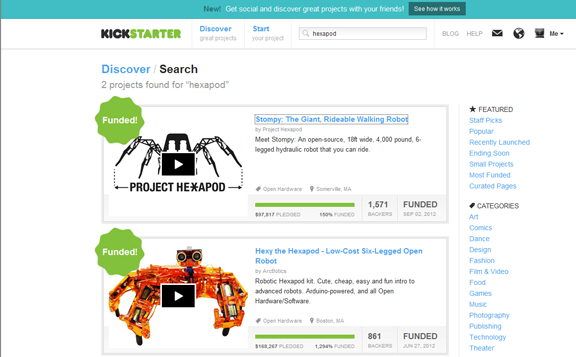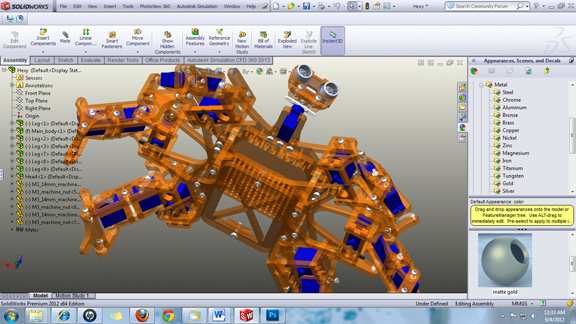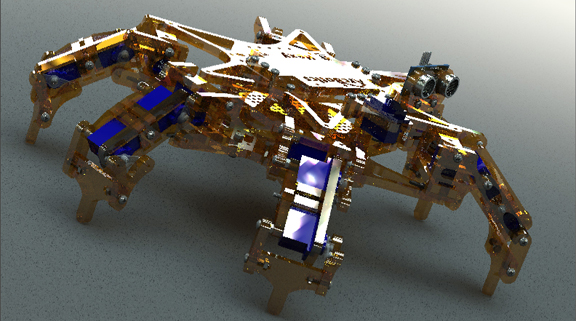September 4, 2012
Artisan’s Asylum, a community craft center in Somerville, Massachusetts, is located about 20 minutes’ walk from Harvard University. It’s also the birthplace of two six-legged robotic crawlers.
Hexy, with a round-eyed head that looks like Pixar’s character WALL-E, is roughly the size of a tabletop inkjet printer (a little bit larger when its jointed legs are extended). It’s the offspring of ArcBotics, a group of robotic students who hope to become “the IKEA of Robotics.” They want to produce robots you can assembly from kits. True to its open source philosophy, ArcBotics shares the CAD assembly of Hexy with the public.
Stompy, a much larger variation, is an 18-foot-tall robot, capable of carrying humans on its back. The two spider-like robots share quite a bit of design DNA. Like Hexy, Stompy is the product of students who were in a robotic engineering class at Artisan’s Asylum. In fact, Gui Cavalcanti, the lead for Project Hexapod (Stompy’s online home), is an instructor for the class. Joe Schlesinger from Hexy’s team was also involved in the early phase of Stompy.
Hexy and Stompy are designed in SolidWorks, the CAD software used by students at Artisan’s Asylum. While designing the six-legged mechanical crawlers in pixels and bites cost little to nothing (other than the cost of CAD licenses), prototyping them do come with significant cost. This is where Kickstarter kicks in, so to speak.
The hexapod makers launched their fundraisings at the crowd-sourced financing portal, appealing to the public to help them bring their concepts into reality. ArcBotics had hope to raise $13,000. The campaign, which began in May and closed in July, was off target by a huge sum: They raised more than $168,000. Stompy’s fundraising began in August; it closed last week. Its target was $65,000; it brought in $97,000 instead.
“I was just kind of amazed at how expensive [hexapod robots] were,” recalled Schlesinger.The $1,200-1,500 price tag would have forced him to subsist on prepacked Ramen noodles for months to afford, he noted. That was his motivation to create a less expensive hexapod.
“When I built mine, I didn’t start with the design and then try to source it,” said Schlesinger. “I started with sourcing, then built the design around it.” His supply-chain-before-design approach produced a hexapod kit that costs $250 for $500. (ArcBotics is now taking preorders for Hexy kits, expected to ship in October.)
The name Stompy, chosen in a voting process, won over Fluffy, recalled Cavalcanti. The current name seems a better fit for a hexapod with legs made up of around 90 unique waterjet-cut steel pieces, and a chassis made up of another 100 unique pieces. In total, Stompy will likely be put together in 650 unique machined pieces.
Because Stompy is expected to carry passengers on its back, its creators did extensive FEA tests in SolidWorks Simulation to study the effects of the anticipated load on its legs. “[Stompy’s shape] is designed to have the lightest, strongest legs it can, which is why they kind of look like excavator arms. The lower legs are meant to be springy, and we needed a simple system by which to do that, which is why they’re on a 4-bar linkage,” explained Cavalcanti.
Stompy is now in assembly stage. The team has begun to wield its gigantic legs, which are estimated to weigh 350 LB each. The entire assembly will weigh about 4,000 LBs. The massive structure itself makes digital simulation a preferred alternative to physical simulation.
Both Hexy and Stompy comprise a number of electrical subsystems. To program and test Hexy, its team used Arduio, an open-source electronics prototyping platform. Because Stompy’s electrical operations are programmed in Python, Stompy’s team used a custom simulation environment built in PyODE, an open-source Python-based physics engine.
Manufacturing, as traditionally understood, is a coordinated effort to mass-produce a design. It’s what Ford or GM does in an automotive plant. Because it requires significant capital and equipment, it’s reserved almost exclusively for those with deep pockets. What you and I do in a workshop or a garage—building a mechanical Godzilla for a neighborhood kid or a LED sculpture to bring to the next Burning Man—is called a weekend project, a hobby. Such undertakings are, by their very nature, limited by the resources average folks have at their disposal.
But crowd-sourced financing portals like Kickstarter are ushering in a new era in manufacturing. Individual projects are on the rise, launched by tinkerers, inventors, and hobbyist who would not otherwise have the means to bring their ideas to reality. (Kickstarter makes it easy to beg without a loss of dignity.) They are often characterized by a desire to create and share rather than to make a profit. They’re the playful experiments not permissible in the established economics of manufacturing.
The pitch for Hexy might never go past a venture capitalist’s receptionist. A loan application for Stompy might never get approved by a bank. But on Kickstarter, the crowd proves generous with good ideas that have legs.
Subscribe to our FREE magazine, FREE email newsletters or both!
About the Author
Kenneth Wong is Digital Engineering’s resident blogger and senior editor. Email him at [email protected] or share your thoughts on this article at digitaleng.news/facebook.
Follow DE








